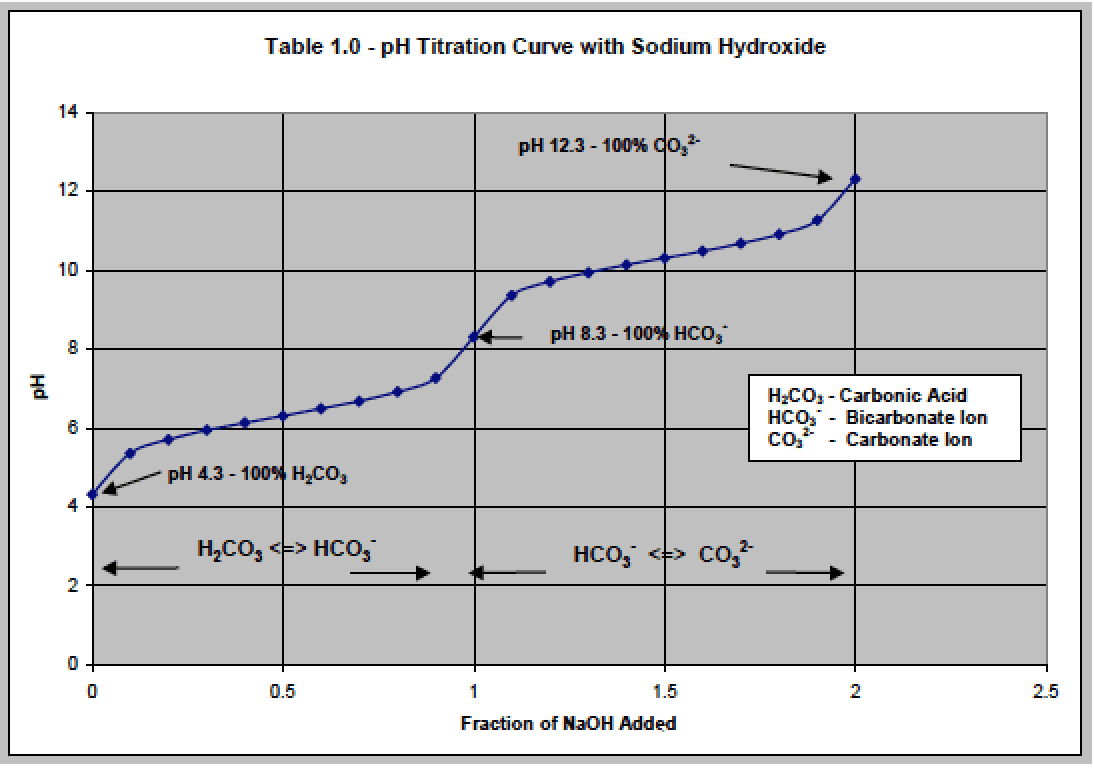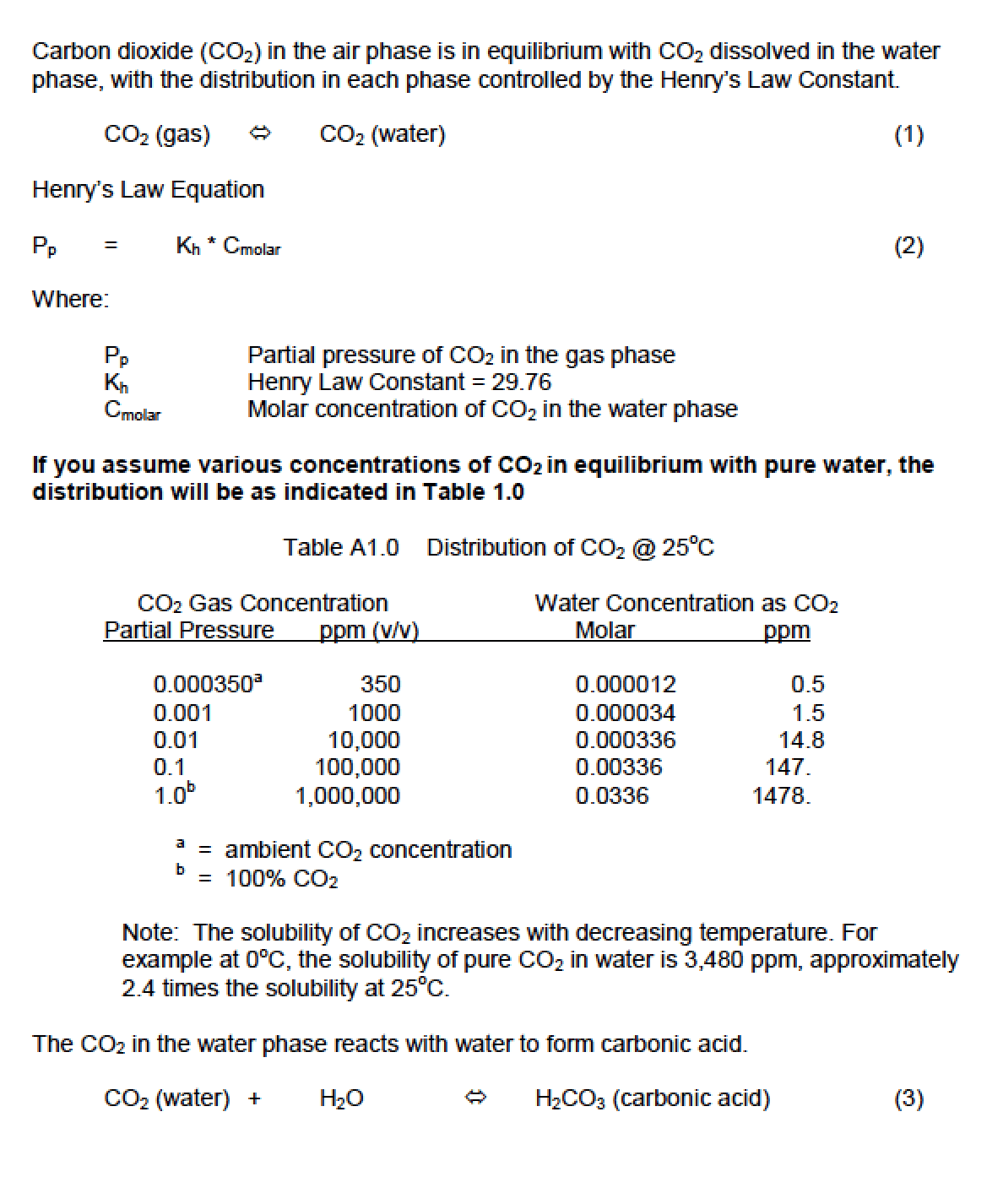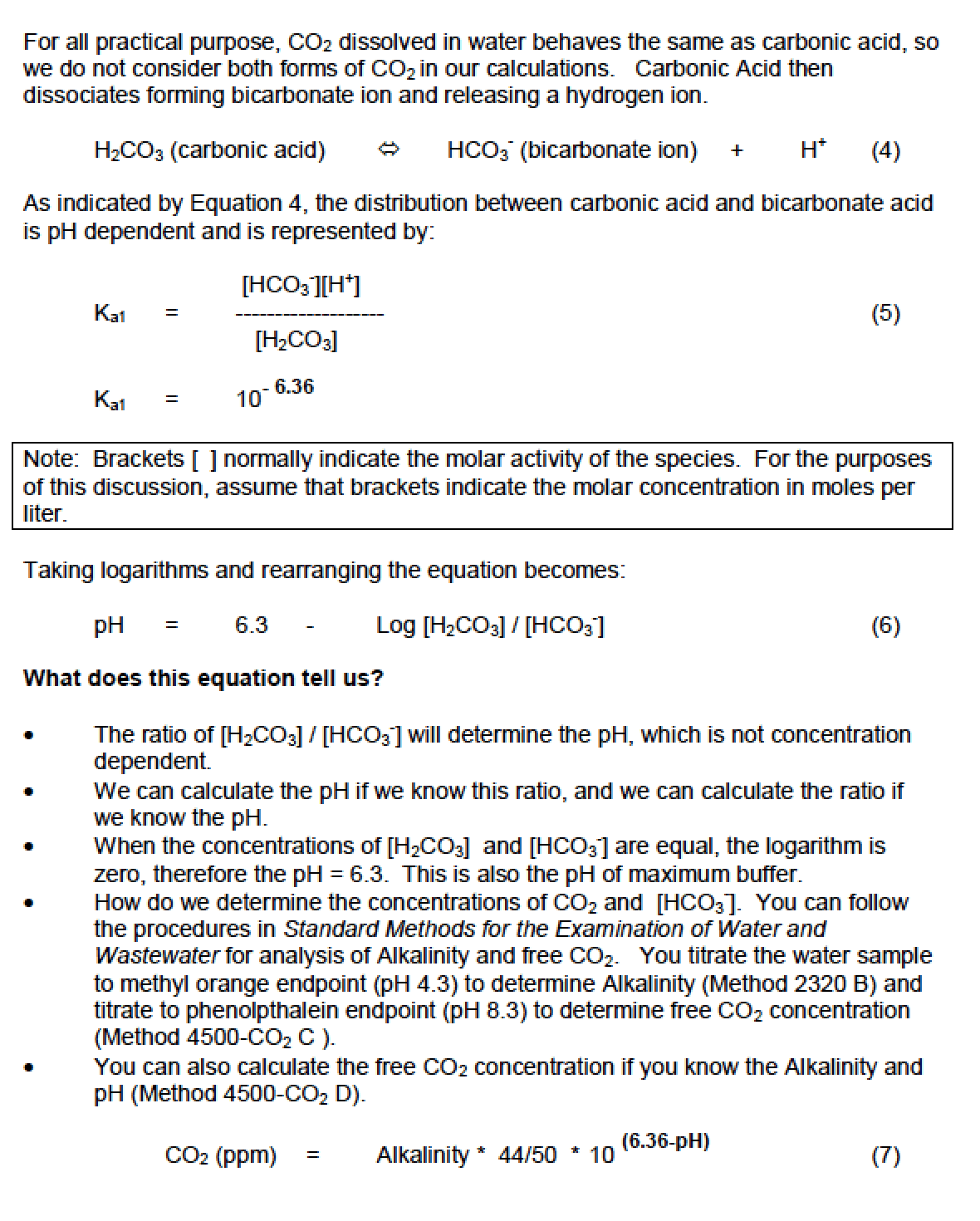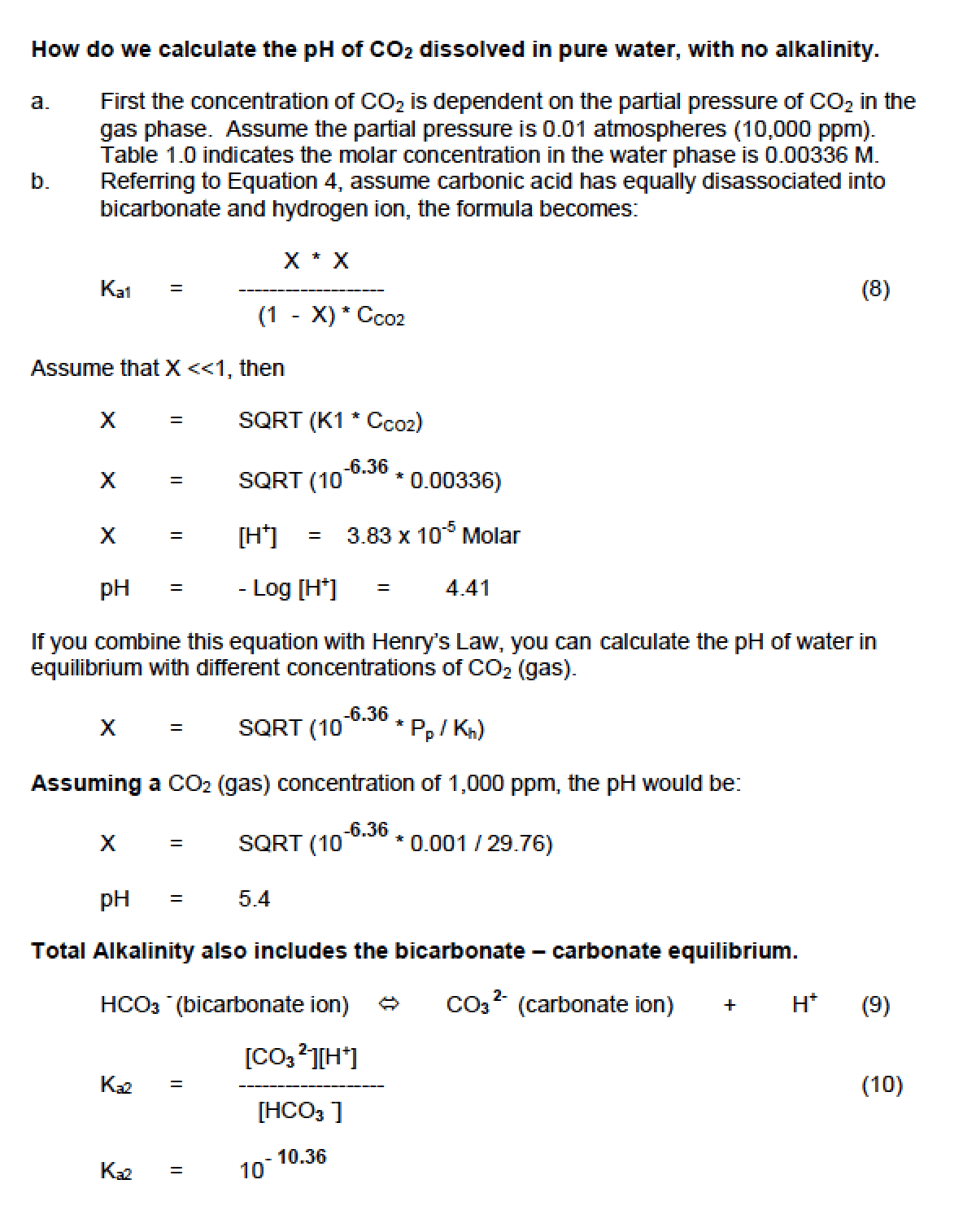Carbonate Chemistry
Applied to the Beverage Production of Still Water
By
Phillip L. Hayden, Ph.D., P.E.
True North Thinking, LLC
591 Congress Park Drive
Dayton, OH 45459
The chemistry of the carbonate equilibrium, including carbon dioxide (CO2), directly affects the beverage production of still water, which has strict pH and alkalinity standards. CO2 (g) will pass through a Reverse Osmosis (RO) membrane, which is commonly used in still water production, and end up in the final water. Unless the CO2 is removed, adjusting the final pH to specifications will result in high alkalinity concentrations in excess of the specifications. The purpose of this paper is to define the carbonate chemistry, present various treatment options and the impact of CO2 (gas) on final still water quality.
1.0 REVIEW
Most ground waters have high levels of hardness consisting of calcium and magnesium ions and alkalinity, which are the carbonate ions. These waters, when removed from the ground, increase in temperature and become oversaturated with respect to precipitation of calcium carbonate. As a result, calcium carbonate scale forms on pipes, valves, heating coils and process equipment. High levels of calcium and magnesium also impact the sensory qualities of carbonated soft drink products (CSD).
In groundwater’s originating from limestone aquifers, the hardness ions calcium and magnesium are normally accompanied with carbonate alkalinity. The carbonate equilibrium, which includes free CO2 or carbonic acid, bicarbonate ions and carbonate ions, is highly pH dependent. The CO2 – bicarbonate equilibrium exists in the pH range of 4.3 to 8.3 and the bicarbonate – carbonate equilibrium dominating at pH 8.3 – 12.3. The concern over carbonate alkalinity is related to the pH buffering of the product, which impacts the sensory qualities of CSDs.
All beverage water treatment plants are designed to remove hardness and alkalinity. For those plants producing only CSD and carbonated water, high CO2 levels in the final water are not an issue since CO2 is added to the final product. It is only those plants producing still water that must remove excess CO2.
A review of the CO2 – Carbonate Chemistry is included in Attachment 1.0. Attachment 2.0 includes a summary of analytical procedures published in Standard Methods for the Examination of Water and Wastewater. Figure 1.0 shows the pH Titration Curve with Sodium Hydroxide.

This pH Titration Curve with Sodium Hydroxide shows the pH – Carbonate equilibrium
and indicates:
- At pH 4.3, only dissolved CO2 (gas) or carbonic acid is present; (Please note for
the purposes of this paper, free CO2 and carbonic acid, H2CO3, are assumed to
be the same.)
- Between pH 4.3 and 8.3, only carbonic acid and bicarbonate ions are present,
with the proportion of each species dependent on the pH. At pH 6.3, the
concentrations of each are equal;
- At pH 8.3, only bicarbonate ions are present;
- Between pH 8.3 and 12.3, only bicarbonate and carbonate ions are present, with
the proportion of each species dependent on the pH;
- At pH 10.3, the concentrations of bicarbonate and carbonate ions are equal;
- At pH 6.3 and pH 10.3, buffers are formed; and
- The pH of a solution of carbonate (say sodium carbonate) is approximately 12.3.
2.0 WATER TREATMENT PROCESSES
2.1 Filtration
The first step in any water treatment plant is filtration to remove suspended solids, normally using a mixed-media filter. Many plants will add oxidants (chlorine) or aerate to water prior to filtration, to oxidize soluble ferrous iron which precipitates as ferric hydroxide solid. Filtration has no effect on hardness ions or alkalinity.
2.2 Dealkalization
Dealkalization involves the use of a weak acid, cationic ion-exchange resin to remove both hardness and alkalinity. The resin is regenerated using a strong acid, such as hydrochloric acid. After regeneration, the resin is on the “hydrogen ion” cycle.
As water is passed through the resin bed, the hardness ions calcium and magnesium are exchanged by the resin and acidic hydrogen ions are released. The acid then reacts with the alkalinity forming carbonic acid (free CO2).

- If you take a sample of water after a dealkalizer, the water is effervescent, releasing small bubbles of CO2 gas
- The advantage of a dealkalizer is that both hardness and alkalinity are removed simultaneously.
- The disadvantages of the dealkalization process are the storage and handling of an acid, such as hydrochloric, which is dangerous and very corrosive.
- Only the hardness ions equal to alkalinity can be removed. Unless the released hydrogen ions can be neutralized by alkalinity, the pH drops thus preventing exchange of hardness ions.
- A gas stripper or decarbonator normally follows a dealkalizer to remove the CO2 gas.
2.3 Membrane Processes
Reverse osmosis membranes do not remove free CO2 gas from water. The gas passes through the membrane and ends up in the permeate.
Some descalant additives that rely on acids to prevent scaling due to calcium carbonate and calcium sulfate will convert all or a major fraction of alkalinity to CO2 gas, which then permeates the membranes (pH 4.5-5.5).
Membrane additives that rely on chelating agents to tie up calcium and magnesium ions are normally used at a neutral pH range (7.0-8.0). At this pH, alkalinity is in the form of bicarbonate ion and associated with calcium, magnesium or sodium ions, which are removed through the membrane.
The membrane permeate water will normally have some free CO2. Because all total dissolved solids, including alkalinity, has been removed, the permeate water has no buffer. With no buffer, the free CO2 lowers the pH to 5.0 – 6.0, depending on the concentration. When the permeate water pH is adjusted upwards, the free CO2 is converted back to bicarbonate alkalinity. Since most still waters have a quality standard of pH >6.5 and < 50 ppm alkalinity, it is possible that when the water is neutralized to a pH > 6.5, the alkalinity exceeds 50 ppm. If this occurs, the CO2 must be removed from the water prior to adjusting the pH.
2.4 Gas Stripping Processes
Dissolved CO2 gas can be removed with a simple gas stripping process. For example, passing a water at pH 5.8 with a CO2 concentration of 120 ppm though a gas stripper can result in a CO2 concentration of <5ppm and resulting pH of 7.0. The key stripping parameters are air to water ratio, temperature and residence time. The specific design parameters of these processes are beyond the scope of this paper.
There are four basic gas stripping process:
- Submerged Aeration;
- Decarbonators;
- Vacuum Degassers; and
- Membrane Degassers.
2.4.1 Submerged Aeration
Submerged aeration consists of blowing air through dispersed bubble aerators installed on the bottom of a tank. The small bubbles produced by the aerators strip out the dissolved CO2 gas and transport to the surface.
Lowry Aeration manufacturers a package aeration system on skids, that includes aeration tank, pump, blower and electrical panel. They can be contacted at 800-434-9080 or www.lowryh2o.com
2.4.2 Decarbonators
Decarbonators are basically packed bed (tower) scrubbers where water is introduced at the top of the packing and air is introduced at the bottom. The contercurrent flow of air and water strips the CO2 from water with the lowest concentration at the bottom of the scrubber. They are normally operated at 0.2 – 0.4 lbs air/lb water.
U.S. Filter offers a wide range of decarbonators, ranging from 15 to 400 gpm, with towers ranging up to 17 feet tall (Models DG-12 to 60). They can be contacted at: Colorado Springs, Standard Products Group.
Additional companies include:
Wesco - http://www.wesco-waterequipment.com/main.htm
GE – Glegg - http://www.glegg.com/products/pr_de_body.htm
Indeck - http://www.indeck.com/h20stats.html
There are many companies that offer decarbonators. Go to the Internet and use the GOGGLE search engine (www.google.com) and seach for “decarbonators”.
2.4.3 Vacuum Degassers
Vacuum degassers are pressure vessels operated at - 5 to 8 psi (500 – 346 mm Hg) vacuum. Vacuum degassers are used in the filling operation of CSD to remove dissolved gases, primarily oxygen. Although vacuum degassers have not been used in the soft drink industry to remove CO2, this is a viable technology.
2.4.4 Membrane Degassers
Gas permeable membranes offer an interesting technology to remove dissolved gases, such as CO2. Membrana offers a membrane technology can be used to remove oxygen and CO2. Water is circulated through a shell (looks like heat-exchanger) consisting of fiber membranes. Air, which is circulated through the fiber side, scours the dissolved gases such as CO2. For more information go to http://www.liqui-cel.com/.
The advantages of vacuum and membrane degassers are:
- Compact systems, requiring relatively small space; and
- Do not require an additional transfer pump.
2.5 Sodium Hydroxide Neutralization
After the CO2 has been removed, the pH should be in the range of 6 to 7. However, if the pH is too low and does not comply with specifications, the addition of sodium hydroxide may be required.
Additional of a strong base, such as sodium hydroxide, to water with low buffer capacity may be difficult to control. Adding too much sodium hydroxide results in high pH and too little results in low pH. To minimize wide pH swings, it is important to measure system parameters and to actually design the system.
To design a sodium hydroxide pH neutralization system, it is important to:
- Match up the feed of sodium hydroxide to the input of acidity. To determine the acidity, you must determine the amount of alkalinity required to raise the water to the desired pH (say pH 7.0). Titrate the water with a pH electrode and stirrer with sodium hydroxide to pH 7.0 and calculate the amount of alkalinity added.
For example, to neutralize 200 gpm of 10 ppm of acidity (as CaCO3), you must calculate the input of acidity in terms of lbs/hour:
12,000 gph/1E-6 * 10 mg/L * 8.34 lbs/gal = 1.00 lbs acidity / hour
Assume 10% NaOH (1.25 lbs alkalinity/lb NaOH).
0.1 lbs NaOH / lb solution * 1.25 = 0.125 lbs alkalinity / lb solution
Will require 1.00 lbs acidity / 0.125 lbs alkalinity = 8.0 lbs 10% NaOH solution
Assume the sodium hydroxide solution has a density of 1.1;
8.0 lbs / (1.1 * 8.34 lbs/gal) = 0.87 gph of sodium hydroxide
The last very important parameter is to locate the pH meter and controller in a position where there is good mixing.3.0 SUMMARYStill waters with low CO2 concentrations can be produced in beverage water treatment plants, providing there is a clear understanding of the carbonate chemistry and the impacts of various treatment processes.There is technology available for stripping CO2 from water provided the systems are properly applied and designed.Attachment 1 – Carbonate Equilibrium Theory





Attachment 2 – Summary of Alkalinity Test Procedures
The bible of water chemistry tests procedures is the latest version of Standard Methods for the Analysis of Water and Wastewater, a joint publication of the American Public Health Association, American Water Works Association and Water Environment Federation.
Alkalinity
The test consists of titrating a sample of water with sulfuric acid to a pH 8.3 and to pH 4.3 (Table 1.0). These pH values reflect the inflections in the pH titration curve where 100% bicarbonate and 100% carbonic acid are present. If the water pH exceeds 8.3, then the alkalinity tests indicates the amount of carbonate and hydroxide present. Titrating to pH 4.3 indicates the amount of bicarbonate present.
To simplify the test, phenolphthalein indicator is used to indicate pH 8.3; and a mixed indicator consisting of bromcresol green-methyl red dyes are used to indicate pH 4.3. In the past methyl orange was used at pH 4.3.
Water treatment people sometimes refer to alkalinity as M & P, to indicate the concentrations obtained titrating to phenolphthalein (P) and methyl orange (M) endpoints.
The alkalinity titration test is listed in Method 2320 B.
Carbon Dioxide (CO2)
Carbon Dioxide can only be present at pH values below 8.3. To determine CO2 concentration, a sample of water is titrated to pH 8.3 using phenophthalein indicator.
The CO2 titration test is listed in Method 4500- CO2 C.
If you know the alkalinity, the CO2 concentration can be estimated according to the following equation.
ppm CO2 = 2 * bicarbonate aklalinity * (106-pH)
If you do not have access to these methods, send an E-Mail to Phil Hayden @ philh@heg.com and I will send you a copy.
If you do not have access to these methods, send an E-Mail to Phil Hayden @ philh@heg.com and I will send you a copy.
